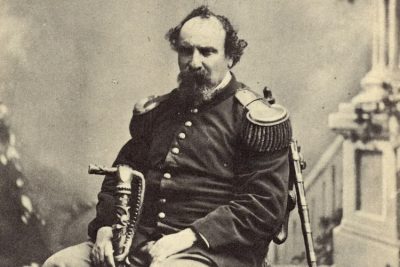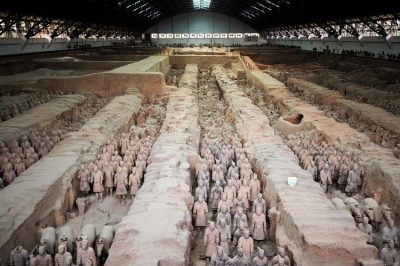Mansa Musa: The ‘Golden’ Emperor of Mali Who Was Reputedly the Richest Man Ever
Share

Artistic impression of Mansa Musa and his army. (HistoryNmoor / Wikimedia Commons)
Imagine being so rich in today’s times that the tokens of appreciation and gifts you gave to a country for their generosity could cause an economic meltdown in that nation! Such is the tale of an African king, who lived during the Middle Ages and had so much wealth in gold that none of the richest tech giants, affluent business magnates or monarchs of the modern world could outdo him even today. Mansa Musa I of Mali unarguably remains the richest man of all time to ever live in human history.
Story of Mansa Musa’s life
Although not much is known about his birth, the earliest records state that Musa was born in the year 1280 into a family of emperors. Related to the first muezzin in Islam, Bilal ibn Rabah, Musa was the great grand-nephew and a direct descendant of Sundiata Keita, the founder of the Mali Empire.
He became the tenth king of the present-day West African country of Mali through regency, and his ascension to the throne was not easy. Musa narrated the account of his coronation to a 14th-century Syrian historian Shihab al-Umari, who mentioned it in one of his documents. It is said that when the king before Musa – Mansa Abu Bakr II – renounced his claim to the throne to explore what was west of the Atlantic Ocean in the year 1312, he took along a large fleet of ships and an entourage of slaves with him to satisfy his wanderlust.
But little did anyone know that his second expedition to the edge of the Atlantic would become the last he would ever undertake. He went missing, never to return. Before his voyage, Abu Bakr II had conferred the regency on Musa to make decisions in his stead, until he returned, in the best interest of their kingdom. So when the sultan did not come back from his voyage after a long period of waiting, an urgent need for a Mansa (ethnic West African tribe of Mandinka used the word mansa, which translates to emperor) arose. That is when Musa decided to take over the reins of the Malian kingdom and was coronated as Mansa Musa I.
The flourishing Mali Kingdom under Mansa Musa’s rule
During the mid-1300s, Europe had become cash strapped and impoverished with civil wars breaking out frequently. But the continent of Africa was flourishing and Mansa Musa left no stone unturned to expand the boundaries of his kingdom. Before Mansa Musa came into power, the realm of Mali was already rich in gold supplies. And when he took over in 1312, he became even more powerful and began to conquer the neighbouring territories on the west of the African continent. His kingdom spread a little over than three thousand kilometers and stretched all the way to the coast of the Atlantic Ocean. He seized control over as many as twenty-four African regions, which include the modern-day countries of Mauritania, Niger, Chad Republic, Senegal, Gambia, Burkina Faso and Nigeria and parts of Guinea-Bissau. Documented records state that the Malian Kingdom under Mansa Musa’s rule stood second in size after the great Mongolian Empire.
There was plenty of natural resources in the kingdom and commodities like salt and gold were in high demand worldwide during those days. Renowned Moroccan explorer and scholar Ibn Battuta mentioned in his accounts that only a year of production could yield a tonne of gold in Mali and that is how the empire kept prospering under the reign of Mansa Musa. During Musa’s rule, Mali alone accounted for almost half of the world’s gold. Trade flourished and the historical city of Timbuktu became the most important hub of business during his reign.
Mansa Musa’s historic pilgrimage to Mecca
Mansa Musa was a devout Muslim and in the year 1324, he undertook a trip of over six thousand kilometers to the holy land of Mecca to perform his Hajj and that was when the world came to know of an African king, who was so rich that he made other kings look like paupers. His travel did not come cheap. Mansa Musa travelled for his pilgrimage, spanning the length of the Sahara Desert with a large convoy and a herd of animals that was a sight for the onlookers to behold. Most documents say that he travelled with as many as two hundred thousand men, but the exact numbers have been varying in some accounts.
His retinue included forty thousand soldiers, courtiers, royal officials, entertainers, heralds, twelve thousand slaves and hundreds of camels and horses, along with several flocks of sheep and goats to provide meat on the journey. As many as five hundred servants were in attendance to his senior-most wife. It appeared as if an entire city was on the way to the pilgrimage through the desert. All of Mansa Musa’s courtiers were dressed in fine Persian silks and gold brocade. His slaves wielded gold staffs that weighed approximately 2.7 kilograms each and every single out of the hundreds of camels is said to carry roughly 135 kilograms of pure gold on it.
When Mansa Musa passed through Egypt
While Mansa Musa’s vast caravan was on the way to Mecca, it passed through Egypt’s capital city of Cairo, where such a rare grandeur was on display for the first time ever. It caused mass hysteria, which as per the documents of Shihab al-Umari, eventually led the ruler, al-Malik al-Nasir to summon Mansa Musa. It was mandatory for a visitor to greet the Egyptian sultan by kissing his hands and feet but Musa refused saying he was on his way to perform his Hajj and in no way would he bow down before anybody else but his God. This made the sultan to finally greet him with respect and admiration and the two kings exchanged pleasantries for a while. The Egyptian sultan played the perfect host to Mansa Musa’s entire retinue for a three-month stay.
As the entourage began on their onward journey, Mansa Musa, in a gesture of his humility, gave away gold to people as gifts. He even flooded the markets with gold dinars purchasing local and foreign commodities. Although gold was in short supply in Cairo in those days, Musa’s generous gifts in gold led to the value of bullion dropping very drastically. His well-intentioned donations led to a cash catastrophe. The depreciation of the precious metal caused a massive financial crunch and the gold market crashed. When Mansa Musa returned from his pilgrimage and passed through Cairo again, he tried to help Egypt recover from the meltdown. He took away some of the gold from circulation by borrowing it for an exorbitant interest rate, yet it took a little more than a decade for the desert country to get back on its feet.
Mansa Musa’s significant contribution to Mali
A generous man, offering to charity at every opportunity, Mansa Musa, on his return trip to Mali from Mecca, purchased lands for his men to stay. He acquired lands in Gao, a territory in the Songhai kingdom, where he commissioned the building of mosques, palaces and audience chambers. Apart from wealth and power, he sought knowledge and brought back Islamic scholars and poets to spread the word of God in his kingdom. Mansa Musa also allowed individuals to practice their own faith and never forced his religion on his people nor was he in favour of conversions. As his empire kept expanding with time, he separated all the territories under his rule and divided them into provinces, appointing governors to oversee them, who reported back to him.
From his travel, he also brought back an Andalusian architect named Abu Ishaq Ibrahim Al-Sahili to build study centres and mosques in Timbuktu. This architect from Granada in Spain went on to construct the iconic Djinguereber Mosque in 1327, which is still standing tall and serving its purpose for a little close to seven hundred years. For this masterpiece, Mansa Musa is said to have paid 200 kilograms in gold to Abu Ishaq, which in today’s times would be approximately equal to 8.2 million US dollars.

Djinguereber Mosque. (JM / Flickr)
Mansa Musa urbanized Timbuktu and commissioned construction work of libraries, schools and art centres. He is also credited as the first person to encourage traditional education in West Africa. Timbuktu became an educational center and students from all over the world came to study at Mali during its golden period.
Mansa Musa I of Mali reigned for about 25 years and died in the year 1337, leaving its reins to his son Mansa Maghan I. But the stories of his great fortune still come as a surprise.
Enjoyed this article? Also, check out “Hetty Green: The Richest American Woman Who Was Known for Her Extreme Miserliness“.
Fact Analysis:
STSTW Media strives to deliver accurate information through careful research. However, things can go wrong. If you find the above article inaccurate or biased, please let us know at [email protected]













